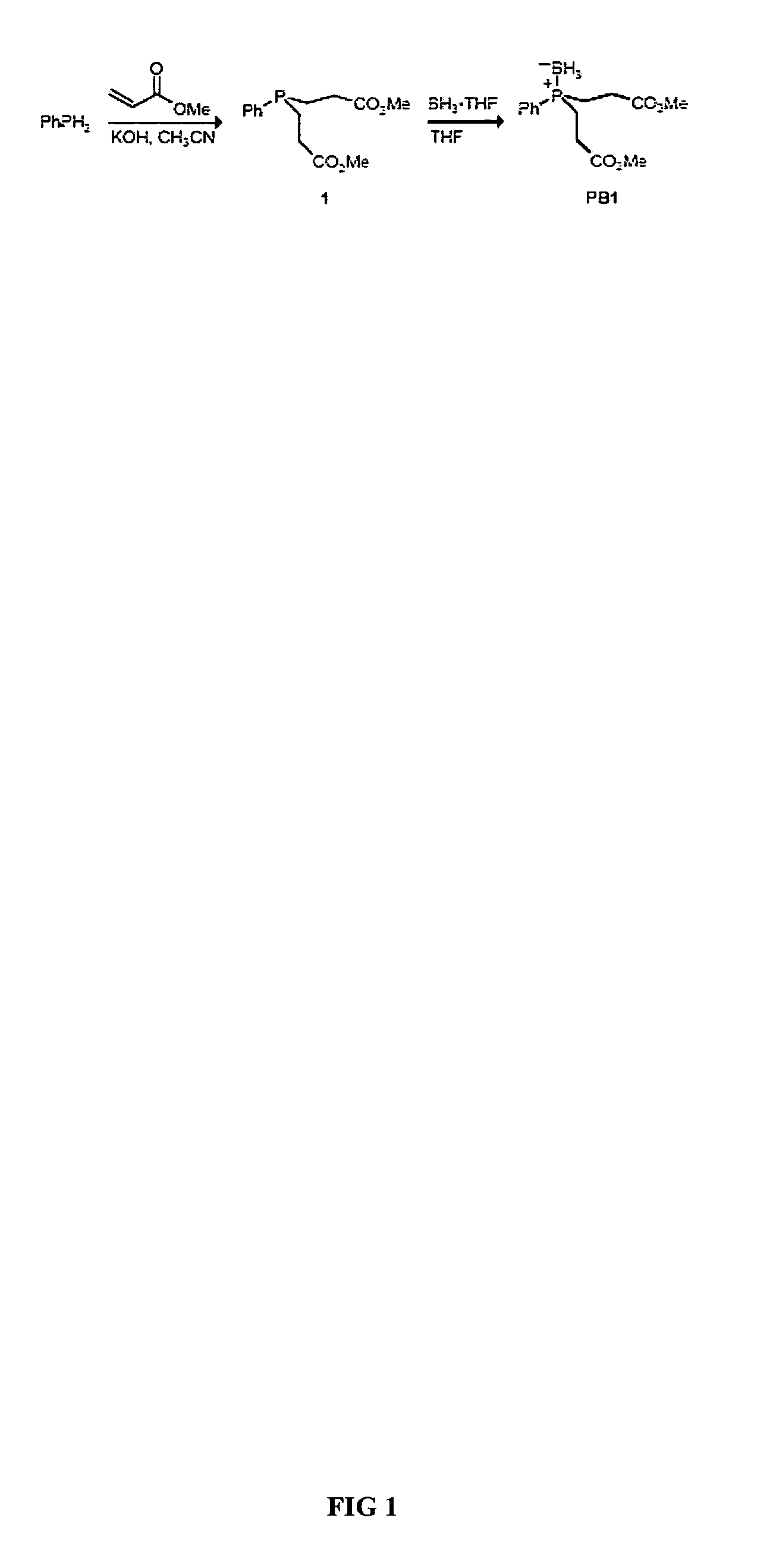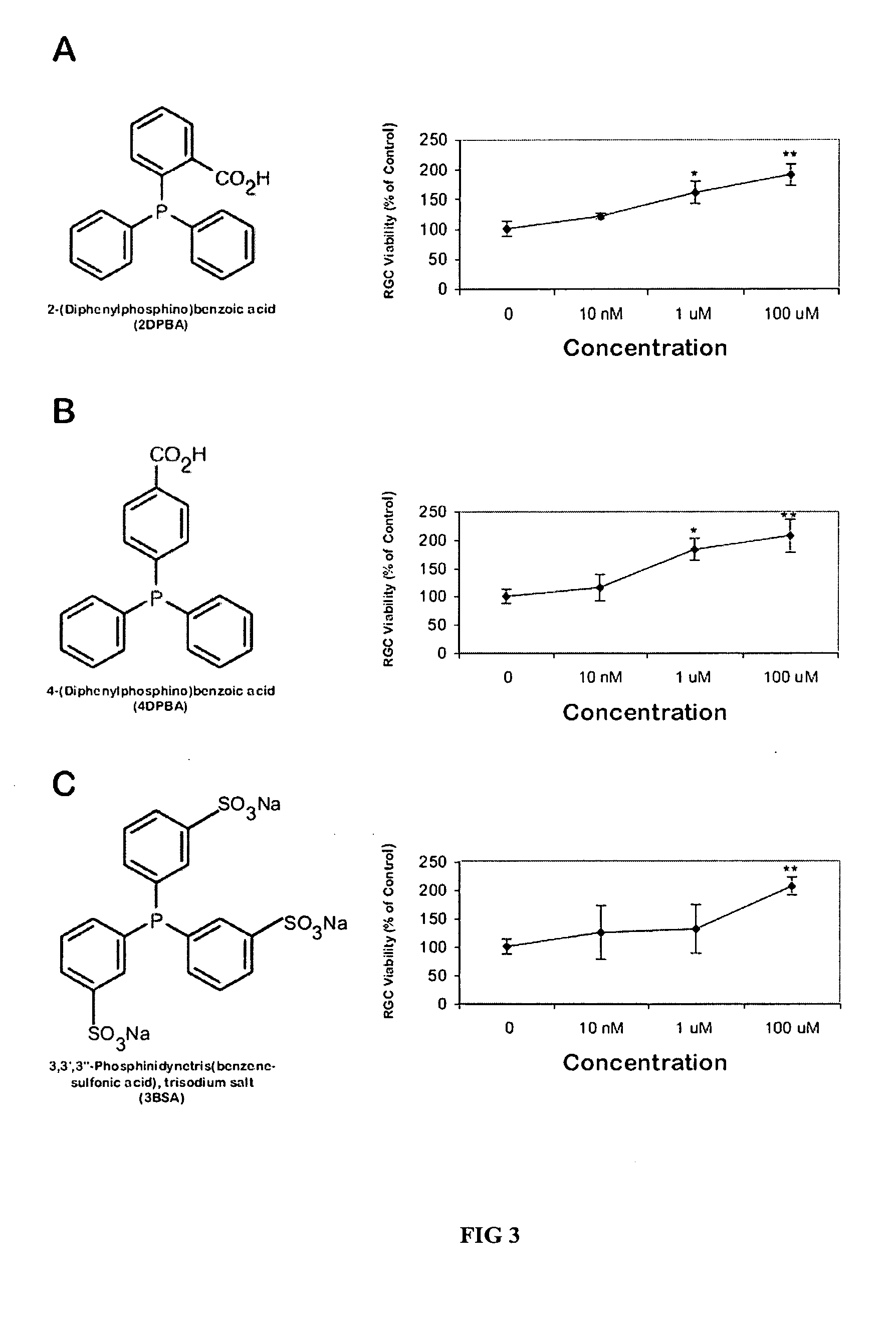Methods of and compositions for reducing neuronal cell death
a neuronal cell and composition technology, applied in the field of methods and compositions for reducing neuronal cell death, can solve the problem of irreversible loss of vision, and achieve the effect of enhancing the survival and viability of neuronal tissue and protecting against oxidative damag
- Summary
- Abstract
- Description
- Claims
- Application Information
AI Technical Summary
Benefits of technology
Problems solved by technology
Method used
Image
Examples
example 1
Neuroprotective Effects of Phosphine Compounds and Derivatives
[0054] Experimental Procedures
[0055] Animals: All experiments were performed in accordance with Association for Research in Vision and Ophthalmology (ARVO), institutional, federal and state guidelines regarding animal research.
[0056] Materials: Cell culture reagents were obtained from GIBCO (Grand Island, N.Y.). A retrograde fluorescent tracer, 4′,6-diamidino-2-phenylindole (DAPI), and a fluorescent viability agent, calcein-AM, were obtained from Molecular Probes (Eugene, Oreg.). Papain was obtained from Worthington Biochemical (Freehold, N.J.). TCEP analogues bis(3-propionic acid methyl ester)phenylphosphine borane complex (PB1) and (3-propionic acid methyl ester)diphenylphosphine borane complex (PB2) were synthesized as described below. Unless noted, all other reagents were obtained from Sigma-Aldrich (St. Louis, Mo.).
[0057] RGC Labeling and Culture: RGCs were retrogradely labeled by stereotactic injection of the fl...
example 2
Preventing RGC Death Associated with Optic Nerve Crush In Vivo
[0076] Experimental Procedures
[0077] Optic Nerve Crush Surgery and Intravitreal Injections: Surgeries are conducted on adult (i.e. eight to twelve week old) rats that have previously received 1,1′-dioctadecyl-3,3,3′,3′-tetramethylindocarbocyanine (DiI) injections. All surgeries are done aseptically and are performed on the left eye only. Animals are anesthetized with a mixture of ketamine and xylazine. A limited lateral canthotomy is performed. The conjunctiva is then incised at the limbus and the subtenons space bluntly dissected posteriorly. Next, 4 μl of sterile drug (i.e. PB1 or PB2) or control (BSS) is slowly injected intravitreally just anterior to the pars plana using a 5 μl Hamilton syringe with a 33 gauge needle. Assuming the vitreous volume of an adult rat eye to be approximately 60 μl (Dureau et al., Curr. Eye Res. 22:74-77 (2001), incorporated herein by reference as if set forth in its entirety), this yields...
example 3
Preventing RGC Death Associated with Ocular Hypertension In Vivo
[0081] Experimental Procedures
[0082] Unilateral experimental glaucoma is induced in the rat using the Quigley protocol for laser ablation of the trabecular meshwork and of the circumferential episcleral vessels. It causes steady RGC loss over a few weeks. See Levkovitch-Verbin et al., Invest. Ophthalmol. Vis. Sci. 43:402-410 (2002), incorporated herein by reference as if set forth in its entirety. The animals are anesthetized as in Example 2. A diode laser at 532 nm (0.2-0.4 watts and 0.3-0.7 second duration, depending on degree of pigmentation) is used to administer laser treatment at the trabecular meshwork and at the episcleral veins draining the perilimbal vessel plexus of vessel. In case a milder IOP rise is required, animals can be treated only at the trabecular meshwork. The laser treatment is repeated at 1 week if the IOP difference between the treated eye and the untreated eye is less than 6 mm Hg. Following ...
PUM
| Property | Measurement | Unit |
|---|---|---|
| surface area | aaaaa | aaaaa |
| temperature | aaaaa | aaaaa |
| temperature | aaaaa | aaaaa |
Abstract
Description
Claims
Application Information
 Login to View More
Login to View More - R&D
- Intellectual Property
- Life Sciences
- Materials
- Tech Scout
- Unparalleled Data Quality
- Higher Quality Content
- 60% Fewer Hallucinations
Browse by: Latest US Patents, China's latest patents, Technical Efficacy Thesaurus, Application Domain, Technology Topic, Popular Technical Reports.
© 2025 PatSnap. All rights reserved.Legal|Privacy policy|Modern Slavery Act Transparency Statement|Sitemap|About US| Contact US: help@patsnap.com



